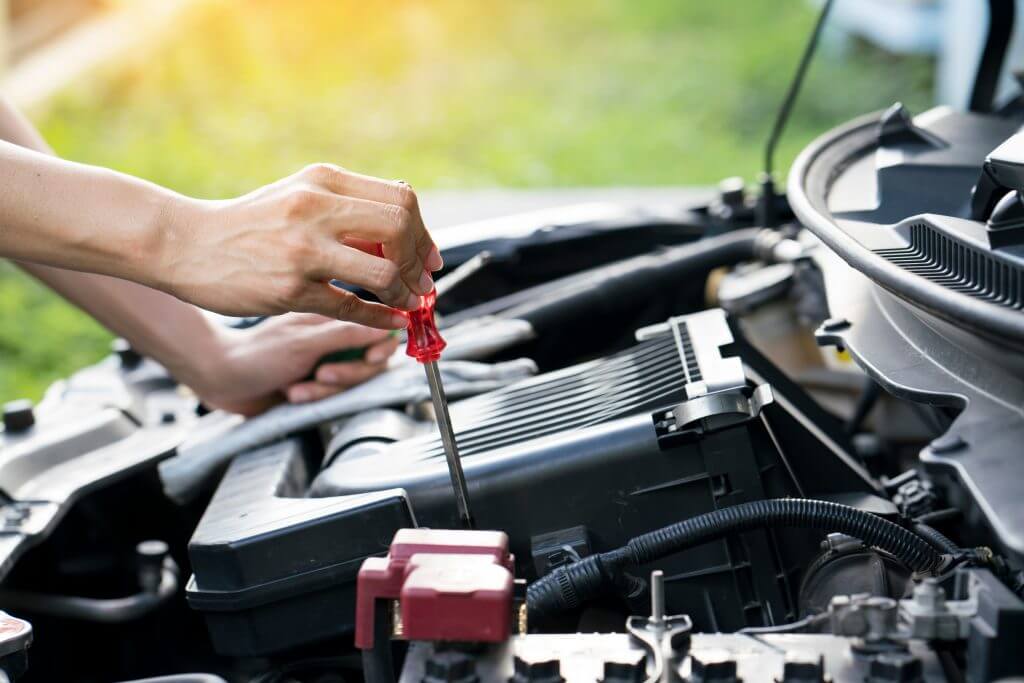Don’t know much about basic car maintenance? FIXD has you covered!
Whether you’re looking to keep your car on the road for years to come or just keep it in great condition to maximize resale value, proper car maintenance is key. On average, Americans now keep their cars for a little over 12 years. Meanwhile, the value of cars (both new and pre-owned) is higher than ever. Bottom line, performing regular car maintenance will have you spending less money on repairs and making more money when it comes time to sell. Talk about a win-win!
But with all the different brands and types of cars out there, it can be hard to stay up to date with the exact maintenance schedule designed for your vehicle. And if you’re a first-time car shopper, it can be hard to know where to start!
Fortunately, whether you’ve owned dozens of cars or you’re about to buy your first, this ultimate guide to car maintenance has all the information you need to protect one of the biggest purchases you’ll ever make.
Here’s what you’re about to discover in this ultimate guide to car maintenance for beginners:
- The “5 Ws” of car maintenance and how you can use them to keep your car running great while saving money – even if you know nothing about car maintenance
- How to beat high prices at the pump with 6 maintenance tips to save on gas
- What items you should check on your car monthly, quarterly, annually, and long-term to prevent costly repairs
- Signs your car needs routine maintenance versus repairs… and which common maintenance tasks you should do yourself vs take to a shop
- How much to budget each month for regular vehicle maintenance
- And much, much more
Chapter 1: Basic Car Maintenance: What You Need to Know
The most important aspect of car maintenance is knowing the five Ws: who, what, when, where, and why:
- Why: To protect your car and save as much money as possible in repairs
- Who: Who will perform the maintenance (DIY vs a professional shop).
- Where: Knowing “where” to look for signs of proper or needed maintenance is also important
- What & When: These are the most crucial elements of basic maintenance to ensure your car is safe and reliable
What is basic maintenance for a car?
Car maintenance can be anything from regular inspections to the replacement of parts (such as the serpentine belt and wiper blades) and/or fluids. Specific maintenance schedules vary depending on the year, make, and model of your vehicle, but, generally speaking, the basic maintenance items are always the same. Refer to your car’s owner’s manual to find out exactly what types of maintenance services are suggested for your vehicle and how often these services should be performed (determined by various time and mileage intervals).
There are no maintenance items that are more important than others since all will affect the life and reliability of your car. Some common services such as oil changes and tire rotations are required more frequently, while others such as timing belts and differential gear changes are done at higher-mileage intervals.
In between all maintenance services, you should inspect your vehicle as often as possible to ensure that everything is operating correctly including, but not limited to:
- Tire pressures
- Headlights (both in terms of working properly and having clean lenses)
- Air cabin filter (don’t forget to clean leaves and other debris from the cowl and under hood area).
When should you get car maintenance performed?
Of all the unknowns that surround car maintenance, the “when” is the hardest to specify. That’s because the type and frequency of maintenance required will vary based on the year, make, model, and even the powertrain options of your car.
The good news is that your owner’s manual will break all of this information down for you, and even if it’s missing, any reputable repair shop will be able to provide you with all of the maintenance information that you need.
Buying a car is one of the biggest expenses that you will ever encounter, so knowing how to properly maintain a car will allow you to protect your investment. Not only does proper maintenance help ensure that your car will be as reliable as possible, but it will also liken the chances for improved resale value and possibly any assistance needed from the OEM or dealership if any major components fail outside of the factory warranty.
Here is a list of benefits you can expect to receive in return for regular car maintenance:
- Improved reliability
- Better fuel efficiency
- Lower cost of repairs
- Maximized safety
- Increased resale value
- Better ability to ask for assistance for out-of-warranty repairs from dealership/OEM
Main components of a car
Modern cars are made up of dozens of components working in concert, but here are the main components of a car grouped into categories.
Click on each of the components below to learn more:
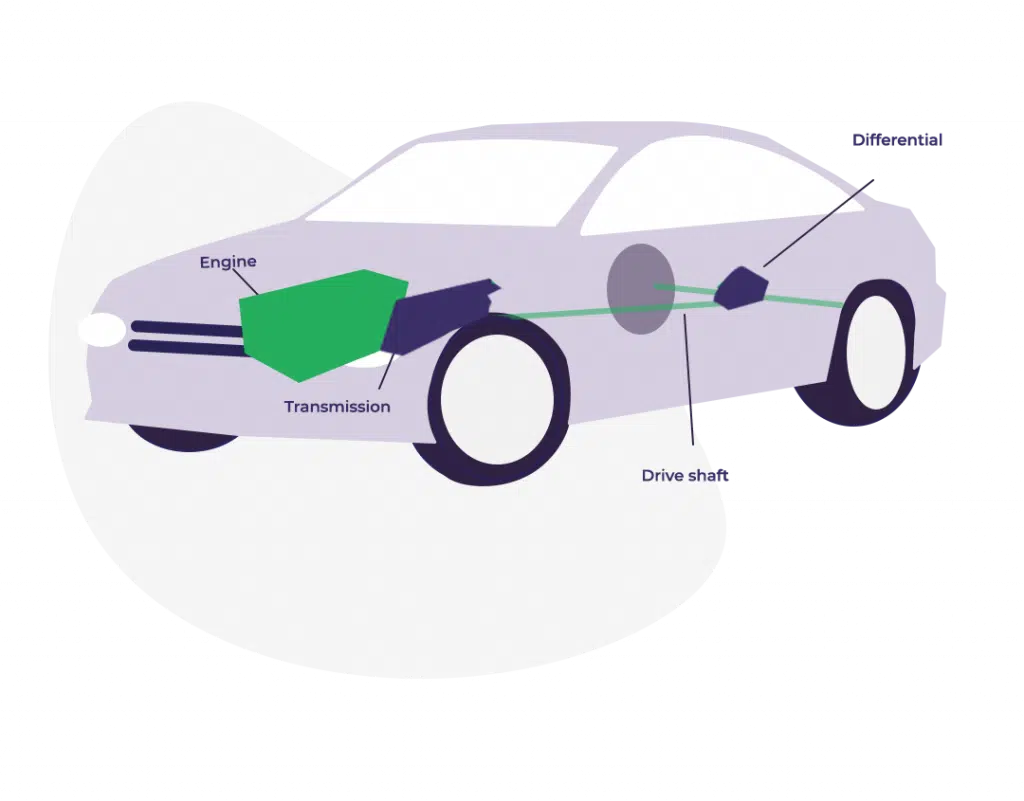

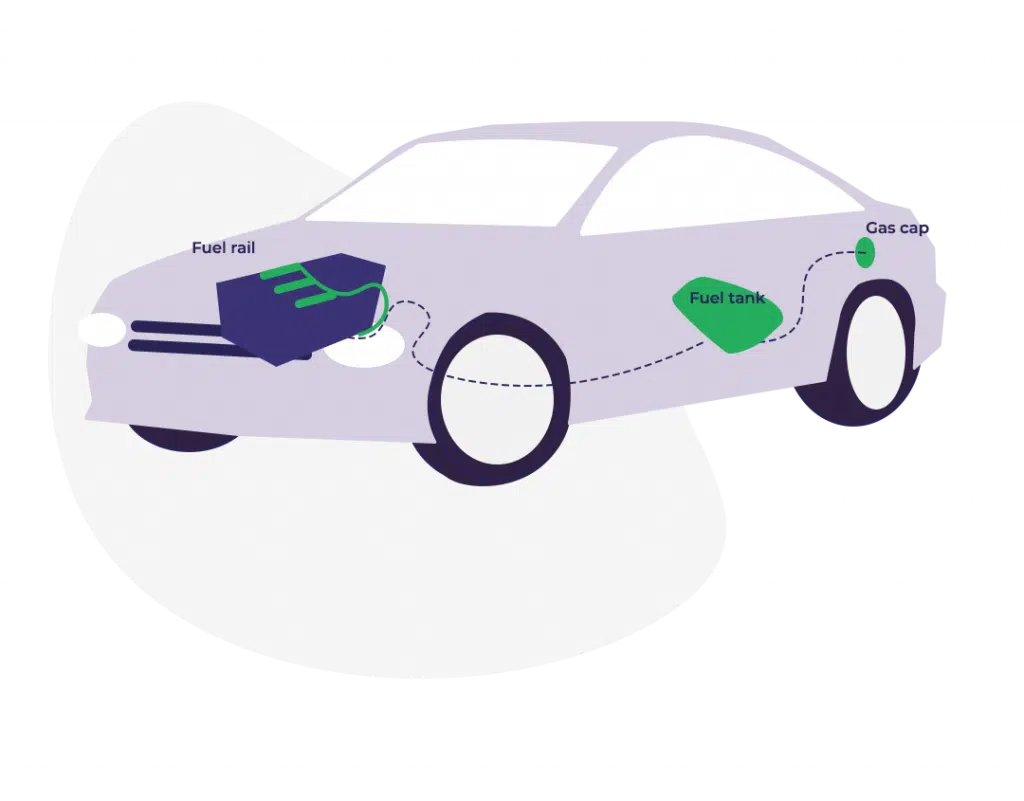

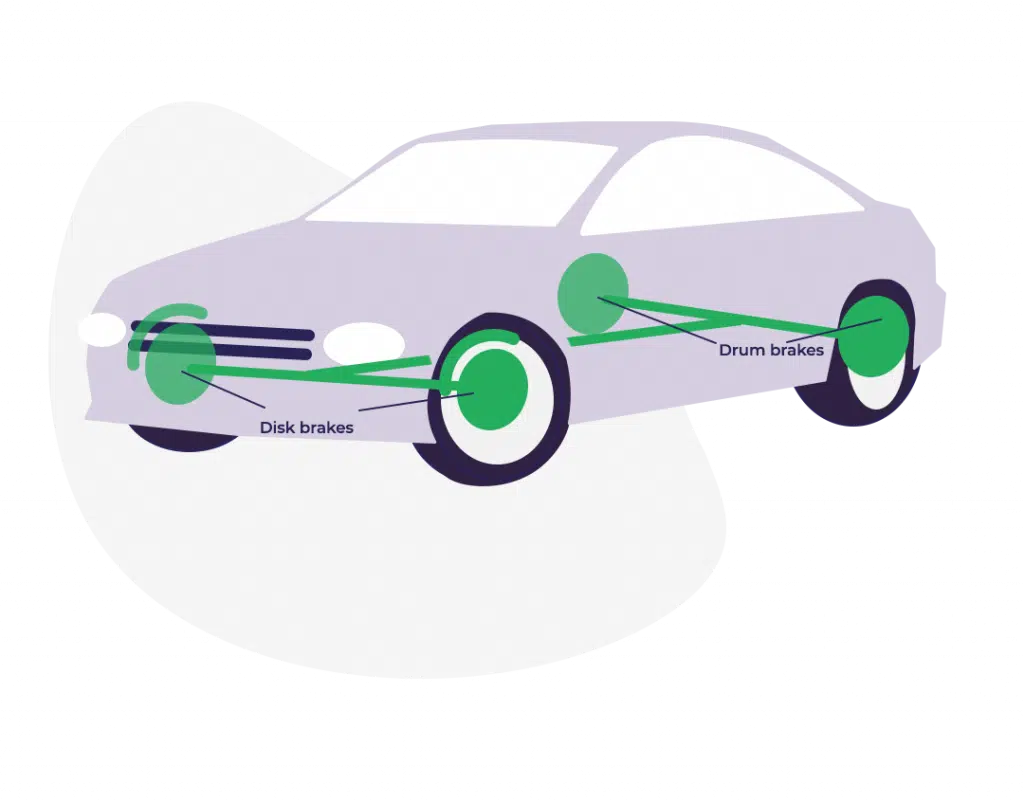

- Powertrain – engine (including the cooling system), transmission, axles, driveshaft, etc.
- Chassis – anything related to the frame whether it’s a unibody or body-on-frame vehicle
- Suspension/Steering – shocks, springs, sway bars, power steering pump, etc.
- Fuel system – fuel tank, fuel pump, EVAP system, fuel injectors, fuel lines, throttle body, etc.
- Brakes – pads, shoes, rotors, drums, master cylinder, brake booster, etc.
- HVAC – heater core, a/c condenser, compressor, cabin air filter, etc.
- Electrical/Body – anything from the computers and battery to the headlights and windshield wipers
As you might imagine, some components of a car are more important to maintain, while others may only require minimal maintenance, which is why automakers have maintenance schedules for each car to ensure all components receive the proper attention at specific intervals.
What parts are the most important to maintain on a car?
In terms of the bigger components that will need maintenance, the powertrain, chassis, and suspension are the most important to maintain as they are not only pivotal to keeping your car safe and reliable, but they are also more expensive to repair if a component fails. Since inspections are an important part of car maintenance, it never hurts to have an inspection performed on your car whenever work is being done to it.
RELATED: 50-Point Vehicle Inspection: What You Need to Know
Signs Your Car Needs Maintenance
This is the “where to look” part of car maintenance, although preventative maintenance should be done frequently enough that your car shows no signs of wear. If you’re noticing things like worn tires, sludgy oil, or a rough-idling engine, you may want to consider performing maintenance items more frequently. The difference between signs of maintenance and signs of repair can sometimes be minimal, but the cost to maintain the main components of your car is always less than the cost to repair.
Signs your car needs maintenance
- Check engine light
- “Maintenance required” light
- Time/mileage recommendations
- Dark or dirty oil
- Dirty filters (engine or cabin air filters)
- Hard starts (fuel filter)
Signs your car needs repairs
- Fluid leaks
- Clunks/rattles
- Broken parts
- Excessively worn parts (tires, belts, brakes, etc.)
Chapter 2: Preventative Maintenance Checklist
Preventative maintenance is essential to keeping all of your car’s components operating as designed, so having a checklist available makes it easy to stay on schedule. As mentioned above, the best place to find information related to your car’s maintenance is in the owner’s manual. If the owner’s manual is missing, this information should be readily available online or at any dealership/reputable repair shop.
Knowing what maintenance items to look out for and how often to have them checked could be the difference between owning a safe and reliable vehicle and owning one that is prone to breaking down or requiring repairs. While exact preventative maintenance schedules are specific to each car, here’s a general idea of what you could expect to see from a maintenance checklist.
Warning lights
Be sure to pay attention to any warning lights that may illuminate on your vehicle’s instrument gauges.
These may include:
- Check engine – suggesting a P0xxx code is present
- Check gauges – your vehicle is experiencing an issue such as overheating, low oil pressure, etc
- Maintenance required – your car’s computer may automatically trip this light when routine maintenance such as an oil change is required
- Battery voltage low – the battery or alternator is not operating properly
- TPMS – check your tire pressures including the spare, if equipped
Items to check monthly
Unless you drive an extreme amount of miles each month, there usually aren’t any maintenance items that need to be performed this often, but there are still things you can/should check:
- Tire wear – uneven may suggest low pressures or faulty suspension components
- Exterior lights – make sure all exterior lights are clear and functioning properly
- Windshield – look for small chips or cracks as these can be repaired before expanding and requiring windshield replacement
Items to check quarterly
Oil changes and tire rotations will probably need to be done every quarter on most cars, so here are some related items to keep an eye out for:
- Oil level – may suggest an oil leak or internal engine issue
- Air filters – engine air filter and cabin air filter
- Brakes – give your brakes a quick check whenever you’re having the tires rotated
- Chassis lubrication
- Fluid levels and conditions – brake fluid, transmission fluid, power steering fluid, etc
Items to check biannually
- Coolant condition and level – perform this check before the extreme summer and winter weather
- Windshield wipers – if wipers are cracked, squeaking, or leaving behind streaks, it’s time to replace them
- Battery – test battery voltage. A battery is considered fully charged at 12.6 volts or higher
Items to check annually
- Serpentine belt – look for signs of cracking or damage
- A/C freon – have the pressures checked before summer weather hits
- Radiator hoses – check for cuts, wear marks, discoloration from age, and minor leaks
Long-term checks
- Timing belt – typically needs replacement every 100,000 miles
- Brakes – generally brake pads last 30,000-50,000 miles, but it’s important to check thickness of the friction materials (whether pads, shoes, drums, rotors). Thickness is often measured in millimeters and each millimeter of thickness can get you through about 5000 miles of driving. A quick Google search will tell you the “minimum brake pad thickness” recommended for your specific vehicle.
- Alignment – your car’s alignment should be checked every time new tires are installed or if any tires start to show uneven wear. Most tire shops will check the alignment for free if adjustments aren’t required.
Chapter 3: Car Maintenance Schedule
The inspection checklist is a helpful way to stay ahead of any potential problems, but regular preventative car maintenance is the best way to keep everything running smoothly. The challenging part about preventative car maintenance is often just knowing what services your car needs and when they need to be performed. Depending on the type of car you drive, oil changes should be done every 3,000 to 10,000 miles, while recommended service procedures are usually mileage based in 15,000-mile intervals.
Below are general recommendations for maintenance items, which aren’t applicable to all cars. Always consult your owner’s manual for exact OEM recommendations. If you don’t love the idea of flipping through a 500-page manual and trying to keep up with your car’s maintenance schedule, get FIXD. For just $19.99, it tracks your maintenance schedule for you, alerts you when it’s time for service, translates the check engine light into plain English, and much more.
| Every 3,000-10,000 Miles | Every 15,000-36,000 Miles | Every 50,000-60,000 Miles | Every 100,000 Miles |
|---|---|---|---|
| Oil and filter change | Inspect and adjust rear drum brakes | Replace tires | Replace timing belt |
| Chassis lubrication | Inspect cooling system | Alignment check | Change long-life spark plugs and engine coolant |
| Tire rotation | Replace fuel filter | Battery test | |
| Inspect engine and cabin air filters (especially if you live and drive in dusty areas) | Replace engine and cabin air filters | Drive belts (including serpentine belt) | |
| Inspect brakes and steering components | Replace wiper blades | Change differential and transfer case fluid | |
| Clean cowl area (under hood) | Change transmission fluid |
Chapter 4: Car Maintenance Tips for Seasonal Driving, Gas Savings, and New Vehicles
Having a regular schedule of car maintenance is essential to keeping your car in the best condition as possible, but there are some maintenance tips you might not find in your owner’s manual.
Performing proper seasonal maintenance will depend largely on where you live and what type of weather your area gets, but it’s never a bad habit to routinely inspect your car to prevent any surprise repairs from popping up.
Spring Car Maintenance Tips
- Check all fluids
- Check air pressures and tread depth (including spare)
- Inspect wiper blades
- Wash and wax exterior, clean and declutter interior
- Remove winter tires
Summer Car Maintenance Tips
- Check all fluids
- Inspect cooling system and top off engine coolant
- Have air conditioning pressures checked
- Inspect wiper blades and top off windshield washer fluid
- Inspect drive belts/serpentine belt
- Check tire air pressures
Fall Car Maintenance Tips
- Clean leaves and debris from cowl area under the hood
- Check all fluids
- Check tire air pressures
- Check heater system/defroster
Winter Car Maintenance Tips
- Check all fluids
- Inspect exterior lights for proper operation
- Perform battery test
- inspect cooling system and top off engine coolant
- Inspect wiper blades and top off windshield washer fluid
- Wash regularly (especially undercarriage), if vehicle is driven on salted streets
- Install winter tires or inspect and properly inflate tires
- Add sandbags to cargo bed for added traction (for pickup trucks in Northern states)
RELATED: Essential Car Winterization Tips
Generally speaking, it’s best to check the level and condition of your engine’s coolant before the extreme temperatures of summer and winter, and while proper tire inflation and wear is always important, it’s especially critical in rainy, snowy, and icy conditions. Autumn is a great time to commonly inspect and remove any leaves that accumulate on the cowl (under the hood), which could cause damage to your HVAC system if not removed.
New Car Maintenance Tips
If you’ve purchased or leased a brand-new car, there are usually certain procedures the automaker will want you to follow to ensure that the engine and other vehicle components aren’t damaged. This might include limiting engine speed or performing an oil change sooner than normally suggested (eg: changing the oil at the car’s first 1,000 miles rather than waiting until 5,000 miles), which is referred to as the “break-in period.”
If you are shopping for a pre-owned vehicle and you don’t know the service history, it wouldn’t hurt to have the vehicle inspected and ask the seller to perform any required repairs/maintenance (or factor these expenses into an offer that is lower than the asking price).
Maintenance Tips to Save Gas
Not only will regular maintenance ensure that your car stays running smoothly, but it will also keep the engine running its most efficient. The keys to maximizing fuel efficiency is having the engine running its best and limiting as much rolling resistance as possible.
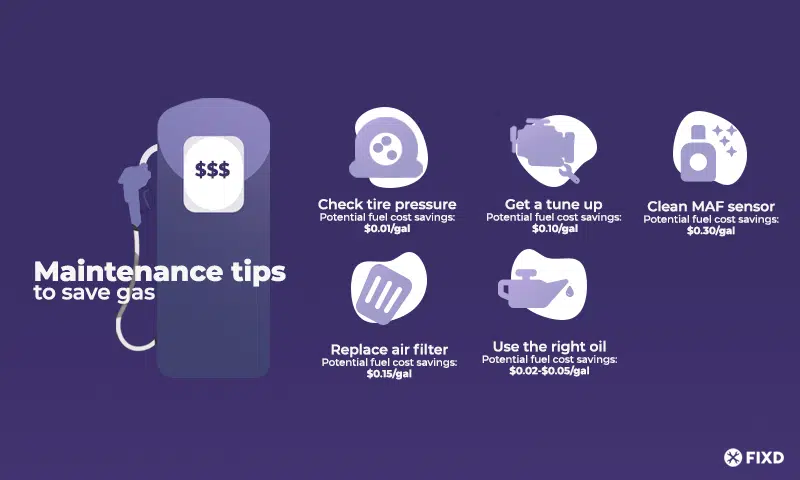

Here are 6 simple car maintenance tips to help you save on gas:
- Check tire pressure: According to the U.S. Department of Energy, keeping your tires properly inflated can improve gas mileage by .6% on average, and up to 3%. Check your owner’s manual for how much to inflate your specific vehicle’s tires.
Potential fuel cost savings: $0.01/gal
- Use the right oil: It’s important to choose the right oil for your engine. Using the recommended grade of motor oil for your specific vehicle can improve fuel efficiency by 1-2%.
Potential fuel cost savings: $0.02-$0.05/gal
- Get a tune-up: Regular tune-ups ensure your engine performs efficiently, improving overall fuel economy. Doing so can improve gas mileage by 4% on average!
Potential fuel cost savings: $0.10/gal
- Replace air filter: Letting your engine breathe easier can improve your fuel mileage by up to 10%.
Potential fuel cost savings: $0.15/gal
- Clean MAF sensor: The MAF sensor on your car is responsible for ensuring the proper ratio of fuel to air in the engine. If this sensor becomes clogged and dirty, it may report incorrect data back to the car’s computer, burning more fuel than necessary and killing your gas mileage. Drivers have reported 1.5-6 mpg increase after cleaning their MAF sensor.
Potential fuel cost savings: $0.30/gal or more
- Clean throttle body: The throttle body takes in filtered air and delivers it to the intake manifold of a fuel-injected car. When this part becomes clogged, it can reduce engine performance and fuel economy. Keep it clean to maximize gas mileage.
Electric Vehicle and Hybrid Maintenance Tips
The maintenance of electric vehicles and hybrids isn’t all that different from conventional cars. Hybrids and plug-in hybrids still utilize internal combustion engines that require the same preventative maintenance as any other car, but be aware that any electrified vehicle probably has some sort of secondary cooling system for the battery, which still needs to be serviced at regular intervals.
Car Wash Maintenance Tips
Regular maintenance just doesn’t keep your car running good, it also keeps your car looking good. You should try to wash your car as often as possible, especially when the paint is covered in thick dust, bird droppings, tree sap, and bug guts. Even if you don’t have time for a full wash, spraying off contaminants quickly will protect your paint in the long run. If you’re not able to give your car a hand wash, look for touchless car washes to avoid any scratches and/or dents that might arise from automatic drive-through car washes.
Chapter 5: Car Maintenance vs Repair
In its simplest explanation, car maintenance is what you perform in the hopes of limiting any repairs needed down the road. Maintenance is a preventative service (such as an oil change or serpentine belt replacement), while a repair is something that needs to be done once a vehicle component has either worn out or broken.
How Much to Budget for Car Maintenance?
According to RepairPal, the average cost to maintain a car is $652/year, including both regularly scheduled maintenance and unexpected repairs. This means you should budget about $50/month for car maintenance and repairs. Considering that a $30,000 car loan with a great interest rate can still cost almost $400/month, it is much more affordable to maintain an older vehicle than to buy a new one.
While maintaining a car and repairing it often require the same tools and skills, preventative maintenance costs far less to perform than repairing worn or damaged parts that result from poor maintenance. For example, failing to properly maintain your engine’s cooling system (about $100 to service) can lead to a shorter life of the water pump, a repair costing as much as $515 on average. Some repairs you can DIY while others you should leave to the professionals. Similarly, an oil change can cost under $20 at some oil-change shops, while a new engine could cost upwards of $10,000. Replacing a timing belt is among the more expensive maintenance items costing, at minimum, several hundred dollars, but doing this service is far cheaper than rebuilding or replacing an engine that has been damaged by a failed timing belt/chain.
Car Maintenance Costs
While the guidelines above should help you budget for important car maintenance, what you pay will vary largely based on the type of vehicle you drive, how many miles it has on it, and where you live. Here are some of the average costs associated with the most common preventive maintenance items:
| Common Car Maintenance | Average Cost |
|---|---|
| Air filter replacement | $20 to $85 |
| Cabin air filter replacement | $10 to $160 |
| Serpentine belt replacement | $58 to $126 |
| Oil change | $40 – $120 |
| Tire rotation | $35 – $44 |
| Replace brake pads and rotors | $311 – $678 |
| Replace windshield wipers | $33 – $82 |
| Battery replacement | $79 – $496 |
| Coolant change/flush | $98 – $123 |
| Spark plug replacement | $66 – $250 |
| Radiator hose replacement | $15 – $424 |
Best Low-Maintenance Cars
Toyota has made a name for itself creating some of the most reliable vehicles on the market, but according to a study by Caredge.com, six of the top 10 most popular cars with the lowest 10-year cost to maintain are Toyota products. Additionally, six of the top 10 luxury cars with the lowest 10-year cost to maintain are Lexus products, Toyota’s luxury division. Below are the top 10 cars for each category as well as the estimated maintenance cost over 10 years for the best low-maintenance cars (not including electric vehicles) broken down by popular brands and luxury brands.
| Popular Brand | 10-Yr Maint. Cost | Luxury Brand | 10-Yr Maint. Cost |
|---|---|---|---|
| Toyota Prius | $4,008 | Lexus ES | $5,488 |
| Toyota Yaris | $4,027 | Lexus IS | $5,680 |
| Toyota Corolla | $4,087 | Lexus GS | $5,721 |
| Toyota Camry | $4,203 | Acura ILX | $7,104 |
| Toyota Avalon | $4,407 | Lexus NX | $7,136 |
| Honda Fit | $4,915 | Acura TLX | $7,634 |
| Mitsubishi Mirage | $4,939 | Lexus RX | $7,398 |
| Toyota Supra | $4,950 | Lexus GX | $7,652 |
| Honda Civic | $5,245 | Acura RLX | $7,683 |
| Honda Insight | $5,303 | Infiniti Q50 | $8,136 |
Highest-Maintenance Cars
European brands are notorious for their high cost for repairs and maintenance, but the study from Caredge.com shows that trucks and work vehicles actually have higher maintenance costs – presumably due to the added mileage, hours, and overall stress put on these vehicles. Below are the top 10 cars for each category as well as the estimated maintenance cost over 10 years for the highest-maintenance cars (not including electric vehicles) broken down by popular brands and luxury brands.
| Popular Brand | 10-Yr Maint. Cost | Luxury Brand | 10-Yr Maint. Cost |
|---|---|---|---|
| Ram HD | $25,844 | Porsche Cayenne | $20,552 |
| Ram Promaster | $20,061 | Porsche Macan | $20,137 |
| Ram 1500 | $17,677 | BMW X6 | $18,900 |
| Ford Super Duty | $15,479 | Mercedes Sprinter | $18,634 |
| Chevrolet Silverado HD | $14,686 | BMW X7 | $18,550 |
| Jeep Gladiator | $11,803 | BMW X5 | $18,389 |
| Ford Transit | $11,701 | Porsche 911 | $18,231 |
| Chevrolet Express | $11,370 | Range Rover | $18,228 |
| Chrysler Pacifica | $10,620 | BMW X3 | $17,711 |
| Jeep Grand Cherokee | $10,484 | BMW X2 | $17,602 |
Chapter 6: DIY Car Maintenance vs Taking Your Car To A Mechanic
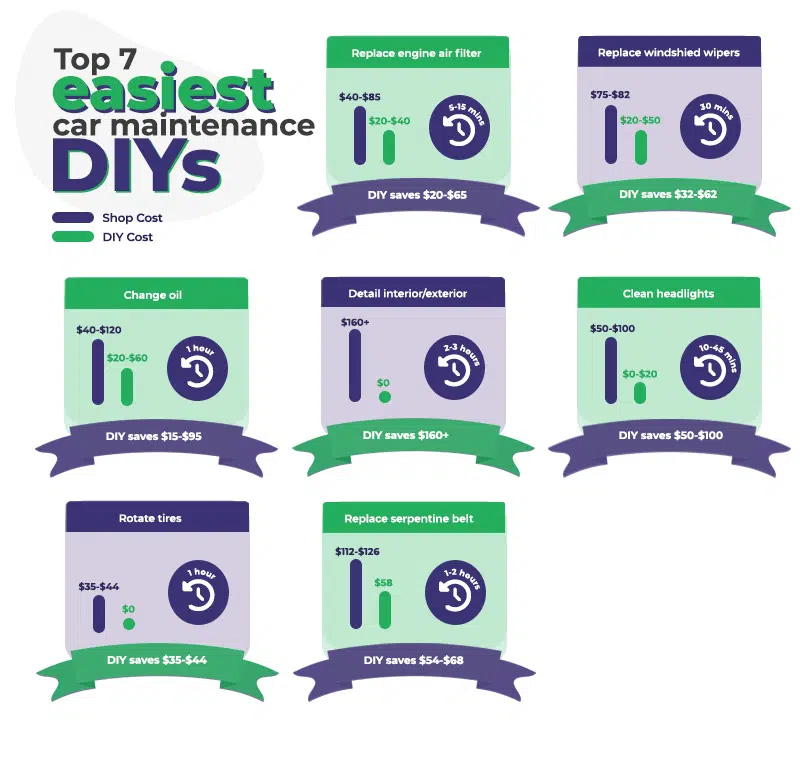

Preventative Car Maintenance Measures You Can Take Yourself
| Easiest DIY Car Maintenance Tasks | Time required | Estimated savings |
|---|---|---|
| Replace engine air filter | 5-10 minutes | $20-$65 |
| Replace windshield wipers | Under 30 minutes | $32-$62 |
| Clean headlights | 10-45 minutes | $50-$100 |
| Detail interior/exterior of car | 2-3 hours | $160 |
| Replace serpentine belt | 1-2 hours | $54-$68 |
| Rotate tires | 1 hour | $35-$44 |
| Change oil | 1 hour | $15-$95 |
Hardest Car Maintenance Tasks
While there are plenty of car maintenance jobs that even beginner DIYers can tackle with minimal tools, here are five maintenance jobs that are best left to a professional mechanic:
- Timing belt/chain replacement: Depending on the vehicle, the engine uses a timing belt or timing chain to keep all of the internal components properly timed, such as the crankshaft and camshaft(s). While metal timing chains last longer than rubber timing belts, both need to be replaced at some point (usually 100,000 or so) to prevent any engine damage. A failed timing belt/chain can lead to expensive engine repairs and possibly even engine replacement.
- Time required: 1 day or more
- Estimated cost: $567 – $743
- Replace struts: While shocks and struts are quite similar, struts are generally not a DIY job if the coil spring has to be swapped from the old part to the new one. Some struts come with a new spring, but they are more expensive. Having to swap the springs can be a very dangerous task unless a spring compressor is used, and these are pricey tools that most DIYers probably don’t need to spend the money on.
- Time required: half day
- Estimated cost: $590 – $896
- Mount/balance tires: Even though a tire rotation is one of the easiest car maintenance items for DIYers, mounting and balancing tires is one of the most difficult. This is because specialized machines are needed to perform each task, and the typical DIYers doesn’t have the need (or garage space) for such equipment. Fortunately, most tire shops will let you bring in loose tires and wheels to have them mounted and balanced.
- Time required: 1 hour
- Estimated cost: usually about $20/tire
- Transmission fluid change/flush: Oil changes might be on the easy list for DIYers, but changing transmission fluid can be a little trickier especially on lower vehicles that have harder access to the transmission pan. The main reason why transmission fluid changes are more challenging is that there is usually no plug to drain the fluid, so the entire pan must be removed, which can be messy.
- Time required: 1 hour
- Estimated cost: $187 – $488
- Recharging A/C system: If your air conditioning system isn’t blowing as cold as it should, it could just be a little low on freon due to a small leak. Auto parts stores sell some sort of DIY kit to add more freon to your system, but if you need to do this too often, it could prove to be more cost effective to have the leak repaired. The problem is that the equipment needed to vacuum the system and recharge the freon is very expensive.
- Time required: 1 hour
- Estimated cost: $123 – $155
Tools needed for basic car maintenance
If you’re looking to do car maintenance on your own, the good news is that you really don’t need that many tools to perform basic tasks.
- Screwdriver set – flat-head, Phillips, and Torx
- Allen wrenches
- Wrench and socket set – mix of SAE and metric sockets, and ¼” and ⅜” ratchets
- Tire pressure gauge – digital or analog
- Breaker bar – to break loose stubborn lug nuts
- Drain pan
- Funnel
- Flashlight
- Extendable/flexible magnet
Chapter 7: Car Maintenance Insurance
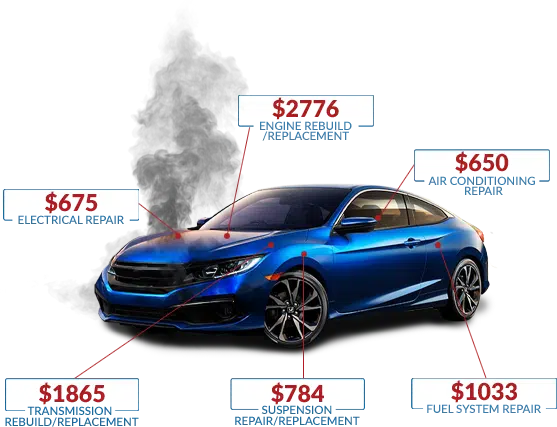
Just like regular car insurance, there are companies out there that offer services for car maintenance insurance, also referred to as car repair insurance or mechanical breakdown insurance. As the name suggests, this is a type of insurance plan that you pay for (usually upfront) and then pays out for any services or repairs your car needs from a repair shop. The downside of these plans is that they normally aren’t helpful for DIYers, but they can still be worth it if you drive a high-maintenance car or if you put a lot of miles on your car. If you’re in the market for such a service plan, be sure to check out the FIXD Vehicle Protection Plan.
Chapter 8: Car Maintenance App
In our busy lives, it can be very difficult to stay up to date with our vehicles’ maintenance schedules. That doesn’t mean you have to wait for a “maintenance required” or “check engine” light to illuminate to remind you of needed services. Rely on the FIXD sensor and app to provide vehicle-specific maintenance information to take the stress and guesswork out of car maintenance. With the FIXD sensor, you will get accurate maintenance reminders sent straight to your smartphone, giving you ample notice of any services recommended for your year, make, and model.

Car Maintenance FAQs:
Why does my car say maintenance is required?
If your car’s “maintenance required” is illuminated, chances are that it has come on based on a pre-programmed time and/or mileage interval. These lights usually come on as a reminder to have maintenance performed on your car, and it is usually turned off by the repair shop. Newer cars will have more specific warning lights such as “oil change required,” but they function in the same way as mentioned above. 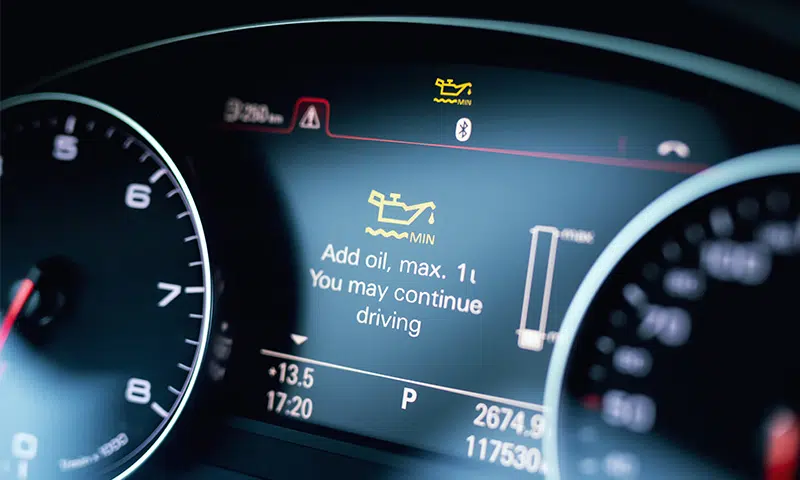
What are the most important car maintenance items?
Generally speaking, all car maintenance items are important, but if you’re trying to cut costs as much as possible, there are some that can be put off a little longer, if the car isn’t abused. That being said, oil changes, brake pad replacement, tire upkeep, and the timing belt are among the most important services you should have performed to best protect your car and maximize your safety.
Do I need full service car maintenance every year?
Most car maintenance items are dependent on mileage, so if you don’t drive your vehicle that often, then you shouldn’t need to follow annual maintenance schedules. Keep in mind that time schedules are usually assuming the car is being driven an average amount, which in the U.S. is about 12,000 miles annually. If you only drive your car 5,000 miles each year, then you won’t need to perform maintenance items as frequently, although you should still have the car inspected often.
Is it worth spending money on car maintenance for an older vehicle?
Car maintenance is important regardless of your car’s age, but it is even more critical on older vehicles to avoid costly, out-of-warranty repairs. The older a car gets and the more miles it accumulates, the more its components need to be properly maintained. On top of that, major maintenance items such as the timing belt and spark plugs are higher-mileage services that should be a top priority for drivers.

Lifelong automotive enthusiast with a soft spot for offroading. Wrencher turned writer, but I still love to tinker on just about anything with an engine. Dream car: tie between a ‘71 Hemi ‘Cuda and a ’91 GMC Syclone. #GirlDad #SaveTheManuals

